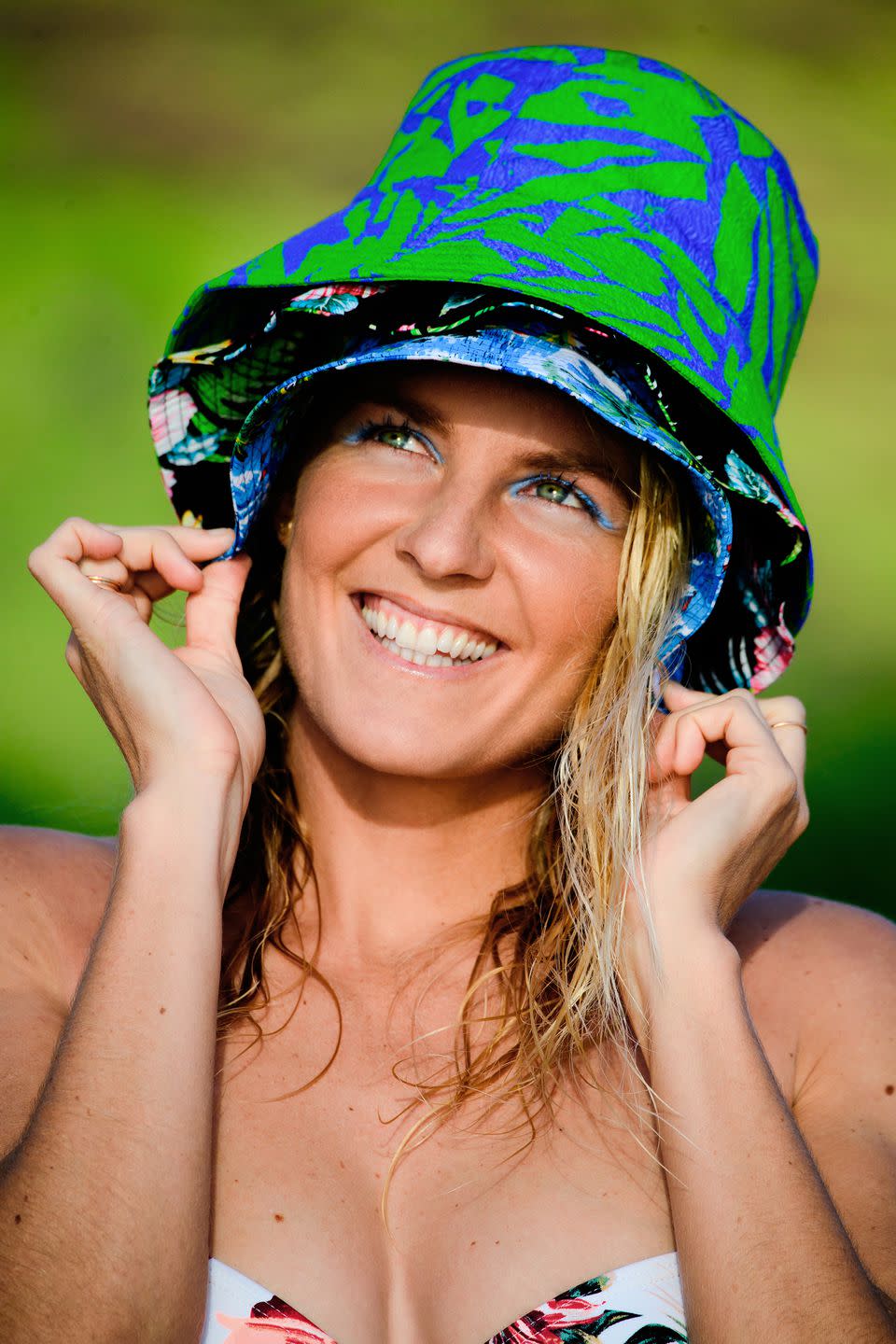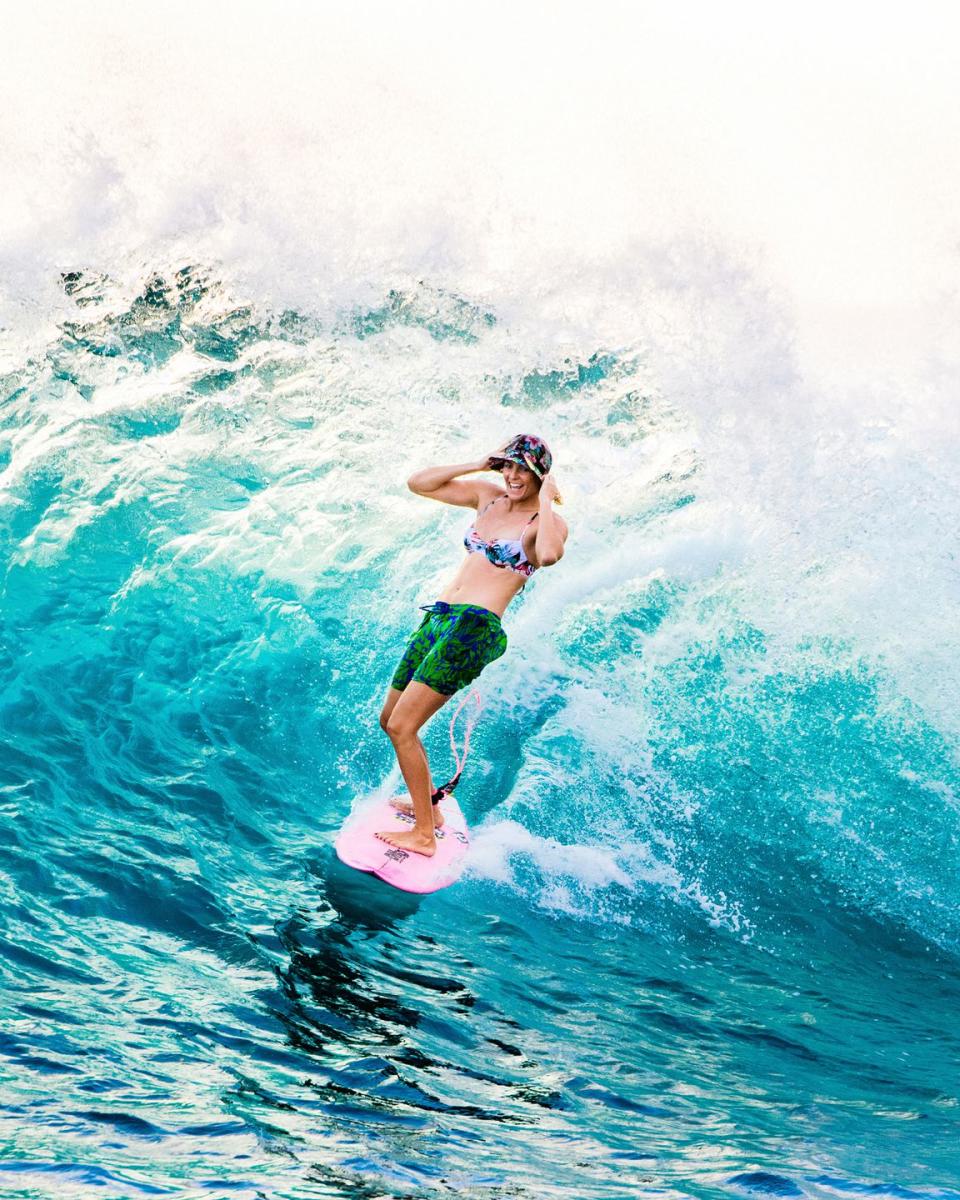Stephanie Gilmore Is the World’s Greatest Surfer. Pay Her Accordingly.

Stephanie Gilmore carves her baby pink board against the turquoise waves at Mākaha Beach in Hawaii with a measured force. While other surfers fight the waves, she slices through them in double the time. She emerges from a crowded break, and beachgoers rise from their towels and squint to see who she is. Her energy ripples through the crowd as her graceful speed-not to mention the fact that she’s wearing a hot-pink anorak for our photo shoot-captures onlookers’ attention. Gilmore is surf royalty.
And she’s making waves where it all started. Just thirty miles north of Honolulu with the Waianae Mountain Range in the background this small pocket of paradise was the birthplace of big wave surfing. Mākaha, in Hawaiian, roughly translates to “savage.” Gilmore upholds its legacy.

Gilmore, 31, grew up in New South Wales, Australia and started surfing at age 11. At 17 she won her first competition and hasn’t slowed down since. Like all pro surfers, she’s chasing the perfect wave competing in one surf tour to the next. She still calls Australia home, but keeps semi-permanent outposts in Hawaii, California, and other cities where the waters swell. She’s a local hero to every surfing community, thanks, in part, to her relentless positivity. Her hometown nickname is Happy Gilmore. She calls herself “happy” four times throughout our interview with a tone of humility that belies her seven world championships.
Just don’t t tell her she surfs like a man.

“Most compliments for female surfing are like, ‘Oh, you surf so well, you surf like a guy,’” she says, adding that she’s heard her surf style described as “masculine” before. It’s the only time throughout the course of our interview that her sunshine-y tone shifts. "No, I think the best guy surfers actually surf like girls." She explains: “Generally I think that most females tend to ride with the wave,” she says. “They're sort of adjusting their maneuvers and everything because physically, we're not as strong as the guys. […] We have to do maneuvers based on what the waves will allow us to do. Guys, they're a little more aggressive. They almost have an abrasive approach where they're fighting against the wave.”
She pauses, and backtracks. “There's no gender to [surfing],” she says. “You can see a relationship that this human has with the ocean when she's riding a wave and that’s what’s really special to watch.” Genderless, however, is not what surfing in 2019 is. But Gilmore has high hopes for the future of the sport, which will be officially recognized as an Olympic sport for the first time at the 2020 Games in Tokyo.
Surfing is notorious for being a boys club, with a long history of sexism and inequality. It’s a territorial sport, all about catching a wave, and women often have difficulty breaking through line-ups dominated by men. The World Surf Tour, the governing body that runs professional surfing competitions, consists of 16 women and 36 men. More often than not the best competitions sets are reserved for men. Gilmore explains: “if the waves are really good, then they put the men on, and if the waves aren't so good, then they put the women on.” But there’s no place where the inequity in surfing is more starkly obvious than when it comes to prize money.

In March of 2018, the men’s winner of the Gold Coast pro received $100,000, while the top woman was paid $65,000. A few months later, a photo of two junior surfers went viral, showing the two teens with their oversized checks. The disparity was blatant; the female winner won half as much as her male counterpart. Female athletes in nearly every sport are fighting the same fight: Serena Williams’ recent campaign for Nike explored the gender bias against women that so often paints them as “crazy” (instead of passionate or ambitious or driven). The U.S. Women’s national hockey team withdrew from competing in an international tournament until they received pay comparable to the men’s team (the exact amounts were never disclosed); And in February 2019, the U.S. Women’s Soccer Team sued for their league for gender discrimination, pay equity and working conditions.
“When men and women are crowned champions and they stand on the podium together and they have an equal prize check, that's so up front and center for everybody to see that this should be normal,” says Gilmore. In addition to surfing finally being recognized by the Olympics, the progress Gilmore and her contemporaries have made tracks with the progress made in more popular sports. For Gilmore, it’s about legitimizing surfing with “more air time on broadcast and to help grow the sport," she says. "If there are young girls out there that want to choose that path of being an official surfer, now they look at me and go, ‘Oh my gosh, it's a legitimate career.’"


Gilmore worked directly with the WSL, and in September 2018 they announced that male and female winners would receive the same prize money. A few months later Gilmore secured her last win in December 2018. ”It's [about] not being afraid to just stand up and use your voice for something and I've always been pretty quiet on that part,” Gilmore admits. “I think for [the WSL], it was just a matter of righting a wrong.”
It’s thanks to big changes like this, and smaller more incremental ones along the way, that surfing is finally becoming a girls’ club too. “We're like a family on the road, whether we like it or not,” Gilmore says of the fellow women on the tour. The roster includes some of her best friends like Tyler Wright and Kelia Moniz (lovingly known as Sis, whom you may have spied on Hailey Bieber's Instagram-the two a re good friends). She gushes about them without pretense. “We really respect each other. So we know that once the event's done, we can come back and all party and celebrate together and it's not an issue.” Pro surfers are constantly appearing on each other’s Instagrams, commenting congratulations, retweeting each others’ accomplishments. It’s peak women supporting women, except they are also each other’s fiercest competitors. Their friendships and feeds are indirectly tearing down toxic surf culture Instagram like by Instagram like.

During our photoshoot, fans young and old approach Gilmore her every twenty or so minutes, like clockwork, to take a selfie or congratulate her. Gilmore is so, well, happy, and easy to talk to, if it weren’t for the constant interruptions it’s easy to forget that she is the best in the world at what she does. But then she reminds me. When I ask if she can surf in a knee-length coat she smiles, “I can surf in anything. I’m a competitive person.”
('You Might Also Like',)
